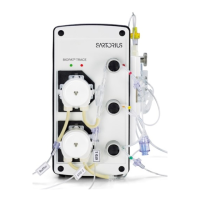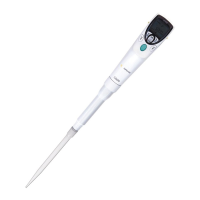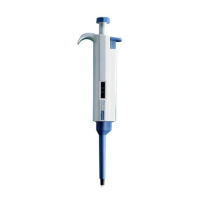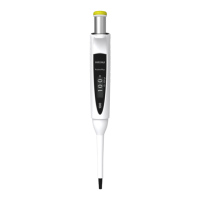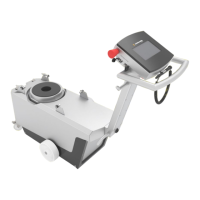16
8.1 Testing Pipette Performance
Performance testing should take place in a draft-free room at 15-30°C, constant to +/- 0.5°C, and with humidity above 50%. The
pipette, tips, and test water should stay in the test room long enough (at least two hours) to reach equilibrium with the room
conditions. Use distilled or deionized water (grade 3, ISO 3696) and an analytical balance with a readability of 0.01 mg (ISO 8655-6).
Weighing
1. Adjust the desired test volume (V
S
).
2. Fit the tip onto the tip cone.
3. Fill the tip with test water and expel it into a waste container five times to reach a humidity equilibrium in the dead air volume.
4. Replace the tip.
5. Pre-wet the tip by filling it once with test water then expelling it into a waste container.
6. Aspirate the test water, immersing the tip only 2-3 mm below the surface of the water. Keep the pipette vertical.
7. Withdraw the pipette vertically, and touch the tip against the inside wall of the test water container.
8. Dispense the water into the weighing vessel, touching the tip against the inside wall of the vessel just above the liquid surface at
an angle of 30-45°. Withdraw the pipette by drawing the tip 8-10 mm along the inner wall of the weighing vessel.
9. Read the weight in mg (m
i
).
10. Repeat the test cycle until you have recorded 10 measurements.
11. Convert the recorded masses (m
i
) to volumes (V
i
):
V
i
= m
i
Z, Z = correction factor (see Table 1: Z-values (μl/mg))
12. Calculate the mean volume (V) delivered: V=(V
i
)/10
13. For conformity evaluation, calculate the systematic error (e
s
) of the measurement:
in μl: e
S
= V- V
S
V
S
= selected test volume
or in %: e
S
= 100 (V- V
S
)/V
S
14. For conformity evaluation, calculate the random error of the measurement:
as standard deviation
or as coefficient of variation CV = 100s/V
15. Compare the systematic error (inaccuracy) and random error (imprecision) with the values in the performance specifications
(see 10.1, Order information and specifications) or the specifications of your own laboratory. If the results fall within the
specifications, the pipette is ready for use. Otherwise, check for both systematic and random errors and, when necessary, adjust
the pipette (see 8.2, Adjusting the pipette).
NOTE: A systematic error (inaccuracy) is the difference between the dispensed volume and the selected test volume. A random error
(imprecision) is the scatter of dispensed volumes around the mean dispensed volume (ISO 8655-1).
NOTE: Sartorius specifications are achieved in strictly controlled conditions (ISO 8655-6). We recommend establishing your own
specifications based on the field of use and the accuracy requirements placed on the pipette (ISO8655-1).
Table 1: Z-values (μl/mg)
Temp. (°C) Air Pressure (kPa)
95 100 101.3 105
20.0
20.5
21.0
21.5
22.0
22.5
23.0
23.5
1.0028
1.0029
1.0030
1.0031
1.0032
1.0033
1.0034
1.0036
1.0028
1.0029
1.0031
1.0032
1.0033
1.0034
1.0035
1.0036
1.0029
1.0030
1.0031
1.0032
1.0033
1.0034
1.0035
1.0036
1.0029
1.0030
1.0031
1.0032
1.0033
1.0034
1.0036
1.0037

